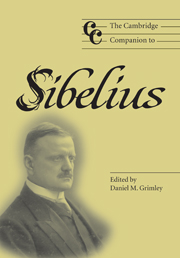Book contents
- Frontmatter
- Introduction
- Part I Forging a voice: perspectives on Sibelius's biography
- 1 The national composer and the idea of Finnishness: Sibelius and the formation of Finnish musical style
- 2 Vienna and the genesis of Kullervo: ‘Durchführung zum Teufel!’
- Part II Musical works
- Part III Influence and reception
- Part IV Interpreting Sibelius
- Notes
- Select bibliography
- Index of names and works
2 - Vienna and the genesis of Kullervo: ‘Durchführung zum Teufel!’
from Part I - Forging a voice: perspectives on Sibelius's biography
Published online by Cambridge University Press: 28 September 2011
- Frontmatter
- Introduction
- Part I Forging a voice: perspectives on Sibelius's biography
- 1 The national composer and the idea of Finnishness: Sibelius and the formation of Finnish musical style
- 2 Vienna and the genesis of Kullervo: ‘Durchführung zum Teufel!’
- Part II Musical works
- Part III Influence and reception
- Part IV Interpreting Sibelius
- Notes
- Select bibliography
- Index of names and works
Summary
When Jean Sibelius, approaching the age of twenty-five, left Finland in October 1890 to study in Vienna, he had never composed anything on a symphonic scale. His teachers, Martin Wegelius in Helsinki and Albert Becker in Berlin, had restricted him to the writing of contrapuntal exercises and chamber works. The young man's experience with orchestral instruments was largely defined by his knowledge of the strings, although he had produced a few works for brass septet. Kullervo, an enormous five movement symphony for full romantic orchestra, baritone and soprano soloists, and male choir, marked an astonishing technical as well as creative breakthrough. Because Kullervo was begun in Vienna, attention has naturally fallen on that city and the composer's experiences there as marking a creative turning point for Sibelius. His love for Aino Jäarnefelt, to whom he had just become engaged, his awakening to the Kalevala, Elias Lönnrot's great collection of epic poetry, and the music he heard have been considered the most important shaping events of those months. Yet Vienna itself was one of the most intellectually fertile cities of the nineteenth century, and the composer's teeming sketchbooks and lively correspondence strikingly attest to its milieu. When studied against their Viennese background, these sources suggest a far richer experience for Sibelius in the Austrian capital than has been portrayed. They also lead to some surprising insights about the most important product of that stay, Sibelius's first symphony, Kullervo.
- Type
- Chapter
- Information
- The Cambridge Companion to Sibelius , pp. 22 - 32Publisher: Cambridge University PressPrint publication year: 2004

